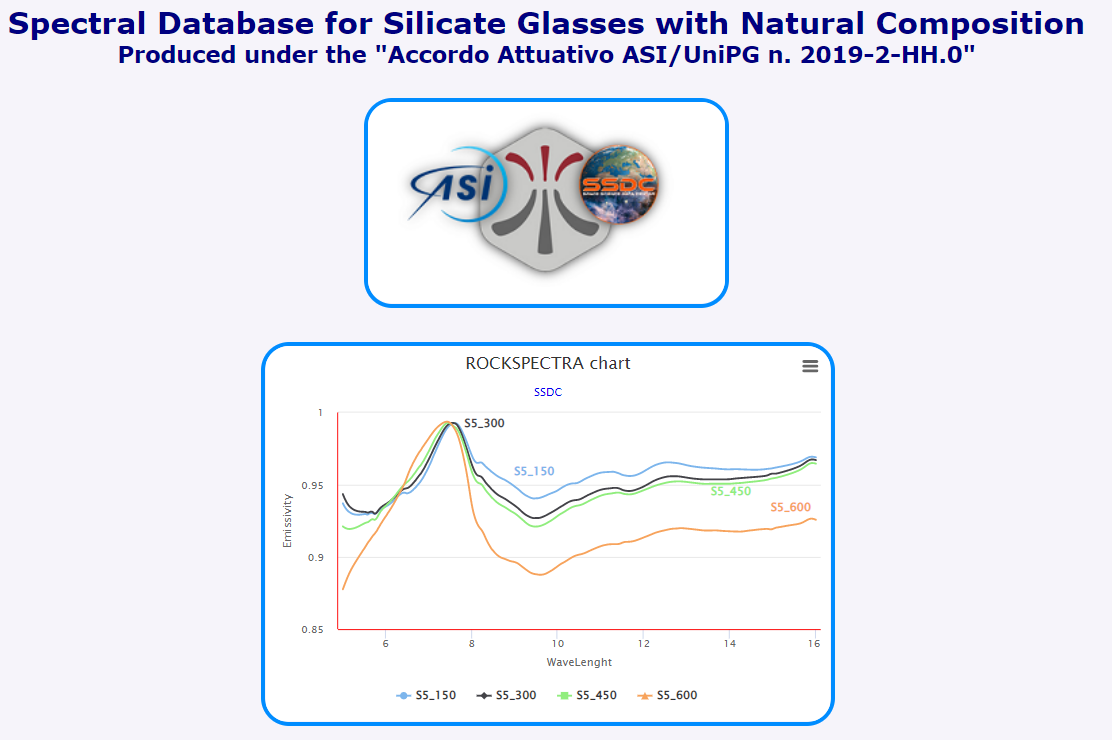A new spectral database for silicate glasses: a fundamental resource to interpret characteristics of volcanic terrains on planetary bodies
- 1Università degli Studi di Perugia, Dipartimento di Fisica e Geologia, Perugia, Italy (alessandro.pisello@unipg.it)
- 2ASI-SSDC/ASI, Roma, Italy
Even if silicate glasses represent a major component in volcanic products, their spectral characteristics are not always considered when dealing with the interpretation of planetary and asteroidal surfaces and terrains. Space analogues described in spectral libraries are mostly constituted of crystalline materials rather than amorphous products. This happens because of the lack of spectral features of amorphous products, but this kind of blurred/featureless spectra are indeed observed on planetary surfaces, and, moreover, very recent studies have shown how amorphous phases can also deeply influence the spectral response of volcanic terrains [1]. For this reasons, the Petro-Volcanology Research Group at the University of Perugia (PVRG) have started an extensive investigation of the spectral response of silicate glasses.
PVRG group has chosen to reproduce in the lab, using experimental petrology tools such as high-temperature furnaces, volcanic glasses with complex chemical compositions mimicking the chemical variability of possible natural magmatic bodies. PVRG have used different techniques to characterize such silicate glasses: reflectance in the Visible and Near-Infrared (VNIR) [2], again reflectance in the Mid-Infrared Region (Mid-IR) [3] and reflectance and emissivity in the Thermal-Infrared Region (TIR) [4].
| Fig. 1: Series of VNIR spectra from glasses having compositions ranging between mafic and felsic, from [2] |
We have observed how different spectral techniques allow us to retrieve interesting correlations between change in spectral characteristics and chemical/textural composition. As examples, we have observed promising correlations between spectral slope/albedo and iron content and speciation of the investigated samples in the VNIR (Fig. 1), but also between silica and alkaline content and spectral shift/shape in the Mid-Infrared Region (Fig. 2). Moreover, it is observed how evolution of spectral shape in the MIR region carries interpretable and useful information on granulometry of the investigated terrains.
These findings suggest that accounting for glassy phases for the interpretation of planetary volcanic terrains is useful because i) it permits to distinguish which parts of the spectra carry information about crystalline phases and which not, and ii) glasses spectra carry themselves important information (iron, silica and alkaline content) that can be used to classify volcanic rocks and therefore to define geological history of planetary bodies. For these reasons, we want to offer a tool where such dataset can easily be observed and investigated.
| Fig. 2: Series of MIR spectra from glasses having compositions ranging between mafic and felsic, from [3] |
The ASI (Italian Space Agency) Space Science Data Center (SSDC) [5] is an infrastructure thought to archive open access data in the field of space sciences for different missions and purposes, and it operates using international standards such as those regarding Planetary Virtual Observatory [6] to maintain and disseminate data applying the FAIR (Findable, Accessible, Interoperable, Reusable) principles. Within SSDC infrastructure, we have created an environment to provide open access to this kind of data by creating a spectral database in which raw spectral data can be found together with the relative peer-reviewed publications in which such data are discussed. Up to now (May 2022) the database is only reacheable through the SSDC pages and with access restricted to people inside the group, but it is already planned to made the catalog completely public in a very near future, not excluding the possibility of making it available as a VO resource in a more advanced phase. Such environment will be explorable in the “Catalogs” list of the SSDC website (https://www.ssdc.asi.it/) under the name Spectral Database for Silicate Glasses with Natural Composition (Fig 3), where it will be possible to visualize, compare, and filter-search spectra, making it a fundamental tool for planetary scientists to account spectra of amorphous phases within their analyses of planetary surfaces.

| Fig. 3: Screenshot of the Database's navigation. |
Acknowledgements
We acknowledge the support of ASI under the ASI-UniPG agreement 2019-2-HH.0.
References:
[1] Leight et al., 2022. Characterization of tephra deposits using VNIR and MIR spectroscopy: A comprehensive terrestrial tephra spectral library. Remote Sensing of Environment, 273, 112965.
[2] Pisello, et al., 2022. Visible and near-InfraRed (VNIR) reflectance of silicate glasses: Characterization of a featureless spectrum and implications for planetary geology. Icarus, 374, 114801.
[3] Pisello, et al., 2022. Reflectance of silicate glasses in the mid-infrared region (MIR): implications for planetary research. Icarus, under review.
[4] Pisello, et al., 2019. Retrieving magma composition from TIR spectra: implications for terrestrial planets investigations. Scientific reports, 9(1), 1-13.
[5] Zinzi et al., 2018. The SSDC contribution to the improvement of knowledge by means of 3D data projections of minor bodies. Advances in Space Research, 62(8), 2306-2316.
[6] Erard et al., 2019. Virtual european solar & planetary access (VESPA): a planetary science virtual observatory cornerstone. arXiv preprint arXiv:1907.06521.
How to cite: Pisello, A., Zinzi, A., Bisolfati, M., Porreca, M., and Perugini, D.: A new spectral database for silicate glasses: a fundamental resource to interpret characteristics of volcanic terrains on planetary bodies, Europlanet Science Congress 2022, Granada, Spain, 18–23 Sep 2022, EPSC2022-539, https://doi.org/10.5194/epsc2022-539, 2022.

